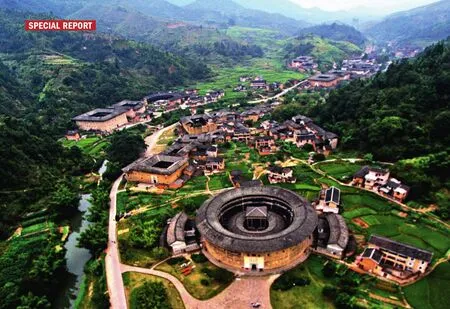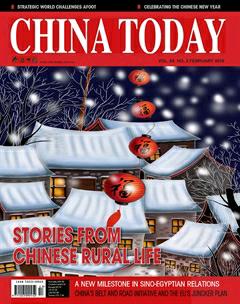“Awesome” Tour Guide Ageng
By staff reporter ZHANG HONG
“Awesome” Tour Guide Ageng
By staff reporter ZHANG HONG

An aerial photo of Tulou buildings in Yongding County with Zhencheng Lou in the foreground.
E VERY m orning local tour guide Ageng, now in his sixties, starts his day’s work at the Tulou sites in Fujian Province by telling visiting tourists all about these earthen structures, which are Chinese rural dwellings, their history and culture, in Hakka-accented Mandarin. Since 2008, when Tulou were designated UNESCO World Heritage, Ageng has been busy receiving tourists and telling them about Tulou culture.
Ageng has acted as guide to more than 10 Chinese national leaders, including Xi Jinping and Hu Jintao, as well as experts from over 30 countries. He thus has the well-earned reputation of “awesome” tour guide.
Since 2008, when Tulou were designated UNESCO World
Heritage, Ageng has been busy receiving tourists and telling
them about Tulou culture.
A Tulou is a rammed earth building with a central public yard surrounded by timber-built dwellings. The homes of the Hakka in Fujian Province, they were constructed in the 12th century. From a bird’s eye view, Tulou structures resemble either giant donuts or UFOs.
Yongding County in southwest Fujian Province, on the southeast coast of China’s mainland, covers an area of more than 2,000 square kilometers. Its total population is mostly Hakka – Han Chinese clans who migrated southwards to escape the chaos of wars in ancient times – and exceeds 480,000. After moving to Fujian, every clan built their own Tulou. Zhencheng Lou, ancestral house of Ageng’s family, is a representative building, and known as a “Tulou Prince.” Covering an area of 5,000 square meters, Zhencheng Lou containsmore than 200 dwellings. The Hakkas have a tradition after a birth of burying the placenta in the Tulou yard, signifying that the infant’s roots are there and that he or she will eventually return.
Ageng’s full name is Lin Rigeng. Back in 1912, Ageng’s grandpa spent five years constructing Zhencheng Lou. In 1985, the Zhencheng Lou architectural model, together with that of the Temple of Heaven in Beijing, was selected for display at an international exhibition of architectural models in Los Angeles, which was a huge success. In Yongding County, as many as 23,000 Tulou are still standing.
Ageng first worked as a tour guide in the early 1980s. At that time, due to inconvenient transport only a few backpackers visited the Tulou, and only four families lived in it. However, Ageng bore in mind the principle of treating every visitor as an honored guest and was very hospitable, sometimes inviting visitors for home-cooked lunch or dinner. Among them were experts and scholars who interpreted the history and culture of Tulou in a very appealing way. Ageng, whose education ceased after elementary school, paid close heed and absorbed much knowledge. Having accumulated a wealth of stories about the Tulou, he soon became the first Tulou tour guide.
Zhencheng Lou was constructed according to the Bagua (Eight Trigrams) relating to the theory in ancient China of yin and yang. Ageng’s household owns the two trigrams qian (meaning heaven) and dui (meaning lake or marsh), and accordingly one quarter of the total Zhencheng Lou.
The Tulou in Fujian Province exemplify the traditional Chinese dwelling still in use today. Visits to these huge buildings give insight into the local people’s architectural skills, and the experiences of Hakkas abroad in earlier times. For example, an issue of the New York Times from 1931 is pasted on the Tulou wall. Today a newspaper this old can be only found in the New York Public Library. The wall also bears a sketch of a Roamer watch.
Since the Tulou was declared a UNESCO heritage site it receives even more visitors. This means brisk business for Ageng. He now receives thousands of tourists each day, and more than 30,000 at peak season.
TuLOu CuLTurE
Great changes take place in Ageng’s hometown with each passing day. The Tulou has also been rated as a national 5-A scenic spot, the number of tourist visits having grown from just over 1,000 in 1984 to more than four million in 2014.

Ageng tells visiting tourists about the history of the Tulou in his family-run restaurant.Zhang Hong
“Before the Tulou became a UNESCO heritage site, its young people would leave their hometown to work in cities. Now most young people choose to come back and launch their own businesses, such as restaurants, or tour guide agencies. The booming tourist industry has brought huge changes to local residents’work and income,” Ageng said. He often remarks to his fellow villagers that the Tulou is their ancestors’ legacy.
Upon seeing off a group of Japanese visitors, Ageng returned immediately to sit and chat with newly arrived visitors sitting at a table groaning with delicious Hakka dishes. This image sums up Ageng’s everyday life.
“I thoroughly enjoy my current life, living with my family and meeting different people,” Ageng said. “Today, many people have money but are still not happy. But we are always glad to live in the peaceful, harmonious Tulou society,” he added.
Great changes take place in Ageng’s hometown with each passing day. The Tulou has also been rated as a national 5-A scenic spot, the number of tourist visits having grown from just over 1,000 in 1984 to more than four million in 2014. In the past visitors had limited access to the Tulou sites. The local government has since invested RMB 500 million in the construction of four highways that link the Tulou buildings with each other and also connect to the outside world.
Thriving tourism business draws migrant workers home. In Ageng’s village, more than 600 villagers who had gone away to work, or married and settled down elsewhere, came back to their hometown to launch their own businesses, including restaurants, guesthouses and retail outlets for local specialties. The permanent resident population has soared from 2,350 in the past to nearly 3,000 at the end of 2014.
Ageng has five children. Lin Shangkang, the eldest son, worked as a teacher for 10 years, and his wife as a tour guide with a travel company. Several years ago the couple both left their jobs and moved back to their hometown to help Ageng with the family business, as did Ageng’s daughter and her husband. The family’s annual income has climbed from more than RMB 40,000 before the Tulou was listed as a UNESCO Heritage Site to more than RMB 200,000 today.
In addition to everyday tour guide work, Ageng has also found time to write books on the Tulou, such as Explore Secrets at Zhencheng Lou and Ageng and Tulou. Ageng is unreservedly grateful to the Tulou. “The Tulou is where our roots are. I am content to live here with my family and enjoy our happy life,” Ageng said.

